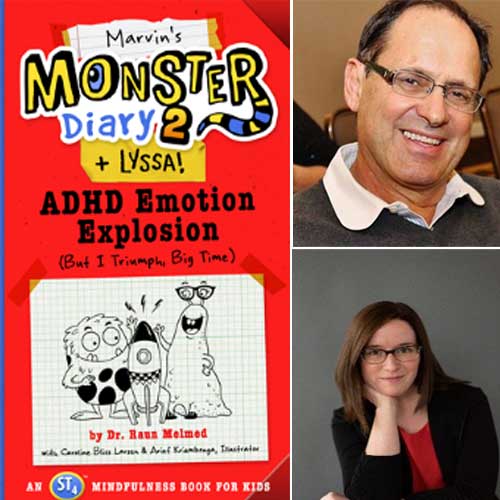Author Interview: Dr. Raun Melmed and Caroline Bliss Larsen, authors of Marvin’s Monster Diary 2 (+ Lyssa!)

Do you have the Monster Diary series in your library? If not, put it on your first fall book order, and order extras! The Monster Diary series combines diary-style storytelling with techniques to handle life with behavioral and stress challenges. This 4-book series is a wonderful way to not only help students but families and teachers alike. We are so pleased that the authors of the latest book in the series, Marvin’s Monster Diary 2 (+ Lyssa!): ADHD Emotion Explosion, pediatrician Dr. Raun Melmed and Caroline Bliss Larsen are answering a few questions about the book for our readers.
As a medical director, developmental and behavioral pediatrician, and founder of The Melmed Center, you have already accomplished so much in pediatrics. What led to your decision to create a children’s book?
Dr. Melmed: As a developmental pediatrician, I see children with special needs, along with typically developing children. The problems they encounter in their lives are all very similar – stress, anxiety, attentional issues, making and keeping friends. In years gone by, doctors would pontificate as to how to manage these issues. Then family-centered approaches became popular. I thought it was high time that we went to the next level – that the child should become central to his/her own care! So, I put pen to paper and took the approaches I’ve used over the years to develop the tools used in this series to enhance mindfulness in children, to empower them to take charge – all in a fun and non-judgmental fashion.
Creating relatable characters is a gift to readers. While your characters share challenges and experiences that many readers face, being a monster is not one of them. Why did you gravitate towards monsters as your characters?
Dr. Melmed: One principle of mindfulness is to take our responses to difficult situations from the gut level and into the brain. For once we think about our behaviors, the behaviors will certainly change. By objectifying these behaviors outside and separate from ourselves, we are more easily able to observe our own responses and make better choices. Through using fantasy, children then are more able to see the behaviors in others and then relate those same observations to themselves. Yes, monsters can be scary – but so is stress, angry meltdowns, and social failure. If those monsters can do it, then so can we!
The Monster Diary series is more than just an entertaining set of stories; it is a valuable tool for children and families experiencing behavioral and stressful challenges. Can you tell us about some of the resources that can be found in the books?
Dr. Melmed: The books include the narrative directed toward the children, along with a parent section which details the specific tools used in each book so that families can incorporate the techniques into the home and of course teachers, coaches, and grandparents can use them as well!
ST4 or Stop and Take Time To Think is the recurring theme through the series. The Monstercam is another popular tool whereby children are taught how to observe themselves from the outside as well as how to “read the room” in stressful situations. Tools for managing time are taught, which can be helpful for screen-time stress. Every child needs a toolbox filled with ideas they can use at stressful times!
Any advice for librarians serving students with behavioral and stress challenges?
Dr. Melmed: The library is probably the safest place for any child – a respite from the daily grind. (My mother was a librarian!) Providing that safe space is the first step. Standing back and observing the child is next. Ask yourself, Why is this child acting in this way? Look beyond the behavior itself and rather at the communicative intent for it. What are possible antecedent causes for it? Most likely, they are stress-related. Then let the child know that you are there for them, that they are indeed safe. Tell them you have heard of some fun tools that other kids use to solve these kinds of problems. Then, of course, explain some of the tools. You will have a fan for life!
How did you meet Dr. Melmed and join in co-authoring this book?
Caroline Bliss Larsen: I’ve been connected with our publisher, Familius, for several years, first as an editing intern and later as a freelance editor. I had the opportunity to edit the previous book in the Monster Diary series, Harriet’s Monster Diary, and loved working on that! I’d read the other books in the series, too, and could sense that these books were important for kids. I never expected, however, to receive an email a couple of months later from Familius asking if I wanted to coauthor the next book with Raun. Obviously, I said yes!
In this sequel to Marvin’s Monster Diary, Marvin is trying to help his friend Lyssa. What problem is Lyssa facing?
Caroline Bliss Larsen: Lyssa is facing a lot of changes in her life at the time of this book: she’s just moved to a new house and new school, leaving behind her friends, her dad, and the familiar. She’s trying to adjust to these new changes but isn’t coping well, and her lack of coping is coming out as anger—at her peers, at her mother (“momster”), at her teacher, and at her new lab partner, Marvin. Even though Lyssa and Marvin couldn’t be more different, and even though Lyssa is struggling, a friendship blossoms between them, and Marvin helps Lyssa cope by sharing some tools that have helped him and his friends deal with their challenges. Their unlikely friendship is not without bumps, however, especially when the Science Scare Fair and middle school glory are on the line.
Several current series use the diary-style approach. Why do you think it has become so popular?
Caroline Bliss Larsen: That’s a great question, and I can’t say for certain what the actual reason is. I can speculate, though. I think a diary format creates a sense of immediacy and suspense—the reader travels through the story alongside the narrator, and neither of them knows what’s going to happen next. And a diary feels more intimate, less filtered—we see what the narrator is thinking and feeling now rather than having hindsight taint that. That sort of reader–narrator intimacy helps readers relate to the narrator, to understand or see themselves in the narrator and to root for them. Of course, we see that in fiction at large, as the first-person point of view, storytelling becomes increasingly more commonplace. Lastly, we can’t overlook the opportunity these diary-style books present for a more visually entertaining experience—which is extra crucial for kids with ADHD, who we hope to reach with these books!
 |
Author Dr. Raun Melmed: Raun D. Melmed, MD, FAAP, a developmental and behavioral pediatrician, is director of the Melmed Center in Scottsdale, Arizona, and cofounder and medical director of the Southwest Autism Research and Resource Center. He is the author of Autism: Early Intervention; Autism and the Extended Family; and a series of books on mindfulness for children: Marvin’s Monster Diary: ADHD Attacks, Timmy’s Monster Diary: Screen Time Stress, Harriet’s Monster Diary: Awfully Anxious, and Marvin’s Monster Diary 2 (+ Lyssa!): ADHD Emotion Explosion. |
 |
Author Caroline Bliss Larsen: Caroline Bliss Larsen edits BYU Independent Study courses by day and writes and edits novels by night. She is also a freelance acquiring editor for Jolly Fish Press and Flux, imprints of North Star Editions. She holds a BA in English language from Brigham Young University, with minors in editing and English literature. Marvin’s Monster Diary 2 (+ Lyssa!) is her debut novel—and she couldn’t be more thrilled! To clear her head of words from time to time, she likes to Irish dance and snuggle her nieces, nephew, husband, and delightfully clingy cat, Cinder. Find her on most major social media platforms or visit carolineblisslarsen.com. |



